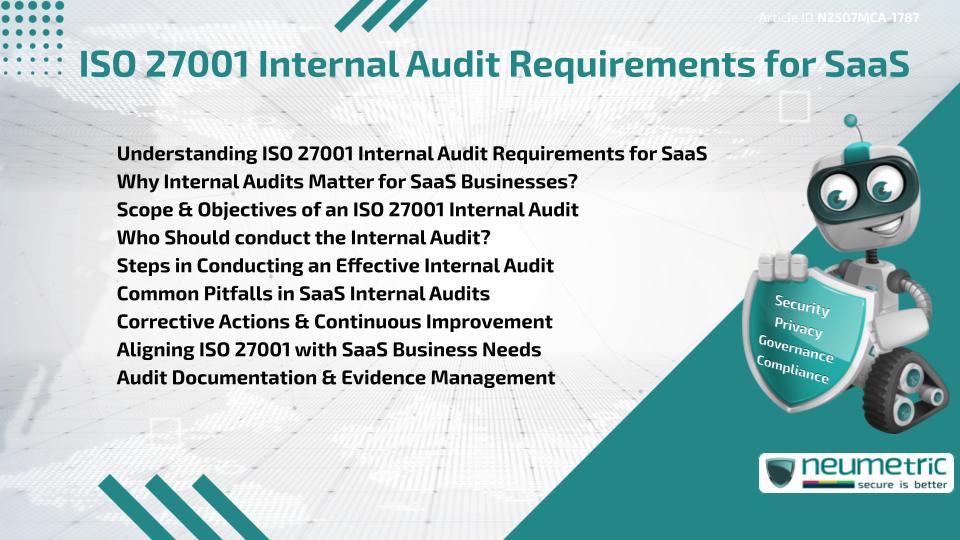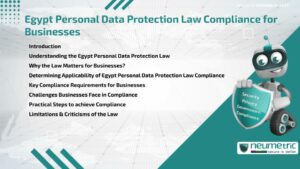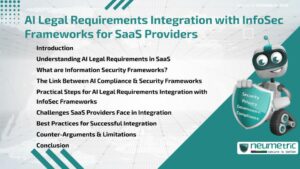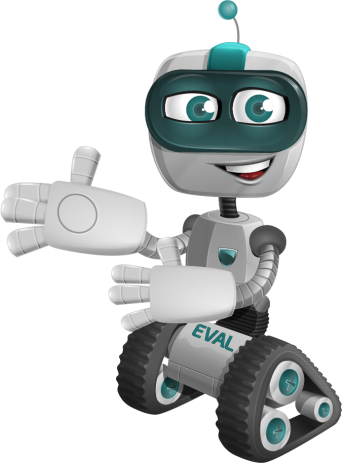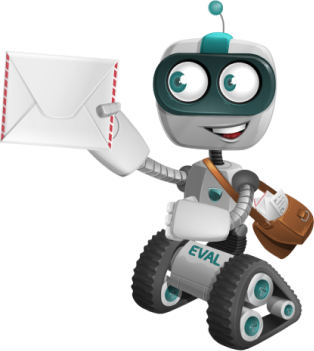Table of Contents
ToggleIntroduction
As SaaS companies grow & scale, protecting Customer Data becomes not just important, but essential. Achieving & maintaining Compliance with the ISO 27001 Standard plays a key role in securing Business Continuity & building Customer Trust. A critical component of this Standard is the Internal Audit, which acts as a self-check mechanism for an organisation’s Information Security Management System [ISMS].
This article breaks down ISO 27001 internal audit steps for SaaS providers. It offers a clear understanding of the purpose, scope & methods for effective internal audits. Whether you are preparing for your first Audit or fine-tuning your existing program, this guide aims to make the Audit process manageable, understandable & valuable.
Understanding ISO 27001 Internal Audit Requirements for SaaS
The internal audit obligations for SaaS under ISO 27001 are detailed in Clause 9.2. This clause requires organisations to routinely assess their ISMS through internal audits. For SaaS companies, this means verifying that technical & organisational controls effectively protect cloud infrastructure, Customer Data & business processes.
Internal audits are performed by or for the organisation, unlike external certification audits.These audits evaluate how well the Security Framework aligns with ISO 27001 controls & how consistently these controls are applied.
Why Internal Audits Matter for SaaS Businesses?
SaaS platforms operate in dynamic environments where threats evolve rapidly. Regular internal audits serve several key functions:
- Confirm alignment with ISO 27001 standards.
- Identify control failures or misconfigurations.
- Highlight areas for improvement before external audits.
- Foster a culture of accountability across teams.
In essence, internal audits help SaaS businesses stay proactive rather than reactive in their approach to security compliance.
Scope & Objectives of an ISO 27001 Internal Audit
The scope of an Internal Audit must reflect the size, complexity & operations of the SaaS provider. For example, a multi-tenant architecture may introduce different risks than a single-tenant model. The scope typically covers:
- Information assets & systems
- Access Control processes
- Data Encryption mechanisms
- Incident Response & recovery plans
The objective is to assess whether these components meet the ISO 27001 Internal Audit requirements for SaaS & to ensure the ISMS is continually improving.
Who Should conduct the Internal Audit?
According to ISO 27001, auditors must be impartial & objective. This means they must not audit areas they are directly responsible for. For SaaS organisations, options include:
- Internal Compliance or security teams (if impartial)
- Cross-departmental auditors trained in ISO 27001
- External consultants acting as internal auditors
The key is independence. The auditor must have a clear understanding of both ISO 27001 & SaaS-specific Risks, such as Third Party integrations or cloud misconfigurations.
Steps in Conducting an Effective Internal Audit
Meeting ISO 27001 Internal Audit requirements for SaaS involves the following structured steps:
- Planning – Define the Audit scope, objectives & schedule.
- Preparation – Review previous Audit reports, Security Policies & control mappings.
- Execution – Interview Stakeholders, inspect configurations & review documentation.
- Reporting – Document nonconformities & observations clearly.
- Follow-up – Make sure corrective actions are implemented & confirmed.
The process must be consistent, trackable & suited to your SaaS setup.
Common Pitfalls in SaaS Internal Audits
Many SaaS businesses make avoidable mistakes that can impact Audit quality:
- Treating audits as a one-time task rather than a continuous process
- Using auditors who are too involved in daily operations
- Ignoring findings or delaying Corrective Actions
- Failing to consider external vendor Risks
Steering clear of these errors can significantly boost your internal audit program’s effectiveness.
Corrective Actions & Continuous Improvement
An Internal Audit should not be viewed as a fault-finding mission but as an opportunity for growth. When issues are found, SaaS Providers must:
- Record the nonconformity
- Determine the root cause
- Implement Corrective Actions
- Monitor effectiveness over time
This aligns with the Plan-Do-Check-Act (PDCA) model that ISO 27001 promotes, reinforcing Continuous Improvement in all security functions.
Aligning ISO 27001 with SaaS Business Needs
SaaS businesses often rely on agility, rapid development & automation. ISO 27001 Internal Audit requirements for SaaS must integrate with these realities. For example:
- Use CI/CD pipelines to enforce code review & access Policies.
- Incorporate Audit checkpoints in DevOps workflows.
- Leverage cloud-native security tools for Evidence Collection.
Making ISO 27001 practices part of daily operations, rather than an added burden, ensures Compliance & efficiency.
Audit Documentation & Evidence Management
Clear, organised documentation is vital for both internal & external audits. SaaS Providers should maintain:
- Audit checklists
- Meeting notes & Stakeholder interviews
- Screenshots of configurations & logs
- Records of Corrective Actions & status updates
Digital evidence should be stored securely & made easily retrievable for future reference. For guidance on secure evidence handling, refer to NIST’s Audit & accountability controls.
Takeaways
- These audits help SaaS providers maintain ISMS effectiveness & manage risks proactively.
- Internal audits must be impartial, repeatable & aligned with business goals.
- Avoiding common mistakes & integrating audits with development processes strengthens Compliance.
- Thorough documentation & actionable follow-up make the Audit more than just a checklist—it’s a driver for continuous security improvement.
FAQ
What is the purpose of ISO 27001 Internal Audit requirements for SaaS?
The purpose is to evaluate whether the ISMS meets the ISO 27001 standard & effectively protects SaaS Business Operations & Customer Data.
How often should a SaaS company conduct an Internal Audit?
Typically once a year, but more frequently if there are major changes to systems, regulations or organisational structure.
Can internal staff perform the ISO 27001 Audit?
Yes, as long as they are independent of the processes being audited & have the necessary knowledge of ISO 27001.
What are the key areas covered in a SaaS Internal Audit?
Areas include Access Control, Data Encryption, Incident Response, Risk Assessment, Third Party integrations & more.
What should be done when nonconformities are identified during the audit?
They must be documented, root causes identified, & Corrective Actions implemented & monitored.
Do SaaS companies need to Audit Third Party vendors?
Yes, especially if vendors process or store sensitive Customer Data on behalf of the SaaS provider.
Is an Internal Audit mandatory for ISO 27001 Certification?
Yes, it is a required component under Clause 9.2 of ISO 27001 & must be completed before the External Audit.
Can external consultants perform internal audits?
Yes, as long as they are acting on behalf of the organisation & meet the requirements for objectivity & impartiality.
Need help?
Neumetric provides organisations the necessary help to achieve their Cybersecurity, Compliance, Governance, Privacy, Certifications & Pentesting goals.
Organisations & Businesses, specifically those which provide SaaS & AI Solutions, usually need a Cybersecurity Partner for meeting & maintaining the ongoing Security & Privacy needs & requirements of their Clients & Customers.
SOC 2, ISO 27001, ISO 42001, NIST, HIPAA, HECVAT, EU GDPR are some of the Frameworks that are served by Fusion – a centralised, automated, AI-enabled SaaS Solution created & managed by Neumetric.
Reach out to us!

